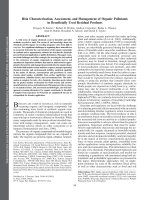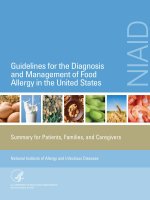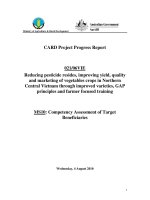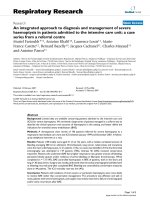Incidence and management of Aflatoxin contamination in groundnut (Arachis hypogaea L.) in northern Ghana
Bạn đang xem bản rút gọn của tài liệu. Xem và tải ngay bản đầy đủ của tài liệu tại đây (179.24 KB, 5 trang )
Int.J.Curr.Microbiol.App.Sci (2019) 8(2): 1296-1300
International Journal of Current Microbiology and Applied Sciences
ISSN: 2319-7706 Volume 8 Number 02 (2019)
Journal homepage:
Original Research Article
/>
Incidence and Management of Aflatoxin Contamination in Groundnut
(Arachis hypogaea L.) in Northern Ghana
Paul B. Tanzubil* and Iddrisu Adam
International Crops Research Institute for the Semi-Arid Tropics (ICRISAT), Tamale, Ghana
*Corresponding author:
ABSTRACT
Keywords
Aflatoxin, Arachis
hypogaea,
Groundnut,
Aspergillus
Article Info
Accepted:
12 January 2019
Available Online:
10 February 2019
Aflatoxin contamination levels were monitored in groundnut products derived from
participatory on-farm demonstration plots, farm stores and markets in 21 districts in
Northern Ghana in 2015 and 2016. Results clearly showed that improved production
technology (variety + agronomic practises) significantly reduced aflatoxin contamination
and increased kernel yield. Though no clear and consistent trend of varietal differences in
aflatoxin contamination could be established from the studies over the two years across
locations, NkatieSari showed the least mean contamination (2.74 ppb and 2.39 ppb) while
SAMNUT 22 had the highest levels of contamination (7.51 ppb and 3.31 ppb) in 2015 and
2016 respectively. Most groundnut products sampled from households and markets, had
aflatoxin levels higher than the EU acceptable limit of 4 ppb and this calls for more
intensive sensitization of value chain actors, especially the processors, and rigorous
monitoring of groundnut products to minimize the risks of human and livestock poisoning
from aflatoxin contamination.
Introduction
Groundnut (Arachis hypogaea L.) is the most
important food legume crop in Ghana in terms
of area of cultivation and utilization,
contributing significantly towards food and
nutrition security, especially among the rural
poor (Awuah, 2000). The bulk of groundnut
production in Ghana about 85 % of the
groundnut production takes place in the
northern Guinea and Sudan Savanna zones
but yields are marginally low, usually less
than 1 t/ha compared with the potential of
2.5t/ha (Tsigbey et al., 2003; Angelucci et al.,
2013). Poor access to improved varieties and
quality seed, poor soils and a high incidence
of pests and diseases account for the low
levels of productivity (Tsigbey et al., 2003;
Tanzubil, 2016). The harvested crop is also
widely contaminated by aflatoxins but the
extent of the problem remains poorly
documented and appreciated, inspite of many
reported cases of its adverse economic, health
and nutritional consequences especially
among rural communities.
Ingestion of high doses of aflatoxin often lead
to acute aflatoxicoses and death, while
1296
Int.J.Curr.Microbiol.App.Sci (2019) 8(2): 1296-1300
smaller doses over time predispose victims to
a range of health problems including stunting
liver cancer, cirrhosis and hepatitis (William
et al., 2013). The USAID-funded Groundnut
Technology
Scaling
Project,
being
implemented in Northern Ghana by ICRISAT
and local partners, is creating greater
awareness
about
aflatoxin
and
its
management using participatory field
demonstrations, sensitization and training of
value chain actors.
The activities described in this paper were
undertaken to:
Improve farmers’ knowledge of, and access to
improved groundnut technologies on aflatoxin
and its management through participatory onfarm demonstrations and training
Assess the effect of project demonstrations on
improved groundnut technologies on aflatoxin
contamination of groundnut produced by
farmers.
Assess the levels of aflatoxin contamination
in key groundnut products across the value
chain.
Materials and Methods
mounted annually using new farmer groups
each time. The demonstration plots were also
used for farmer field days, farmer training,
farmer exchange visits and other project
activities. Pod samples (1kg) were collected
from each plot at harvest, dried and later
analysed for aflatoxin contamination using the
Aflatoxin Mobil Assay (mReader) which
employs Reveal Q+ test strips (Neogen
Corperation).
Monitoring aflatoxin contamination of
groundnut products in the value chain
Samples of groundnut products were collected
annually between November and January of
2015 and 2016 from various sources in the 21
project districts. Pod samples (P) were
collected from farmers’ stores while kernels
(K) and groundnut paste (GP) were sampled
from local markets in the study districts. A
minimum of 15 samples of each product was
collected per district annually and analysed
for aflatoxin contamination as described in
2.1 above. Results from the analysis and their
implications were shared with value chain
actors and policy makers using community
fairs, review meetings, school visits, trainings
and radio broadcasts.
[
Results and Discussion
Farmer participatory demonstrations on
improved groundnut production and
aflatoxin management technologies
Aflatoxin levels in
demonstration plots
Participatory demonstrations on improved
groundnut production technology (varieties,
agronomic practises) were conducted by the
various project partners from 2015 to 2017,
using 10 m X 10 m on farmer fields in the 21
project districts in Northern Ghana. Each
demonstration compared 3 improved varieties
(Yenyawaso, NkatieSari and Samnut 22) +
improved agronomic practices with the
Farmer variety and crop management. A
minimum of 140 such demonstrations were
Pod
samples
derived
from
2015
demonstration plots had aflatoxin levels
ranging from 1.46 to 19.72 ppb with a grand
mean of 6.51 ppb. In 2016, aflatoxin levels
were generally lower with a grand mean of
3.95 ppb and a range of 1.01 ppb to 13.59 ppb
(Table 1). This is an indication that the project
demonstrations of introducing improved
varieties and agronomic practices to farmers
had the desired effect of reducing aflatoxin
contamination.
1297
harvests
from
Int.J.Curr.Microbiol.App.Sci (2019) 8(2): 1296-1300
All the improved varieties/agronomic
practices plots showed lower levels of
aflatoxin contamination than the farmers’
variety/practice. Among the improved
varieties however, no clear and consistent
trend of varietal differences in aflatoxin
contamination could be established from the
studies over the two years across locations.
Overall, Nkatie Sari showed the least mean
contamination of 2.74 ppb and 2.39 ppb while
SAMNUT 22 had the highest levels of
contamination of 7.51 ppb and 3.31 ppb in
2015 and 2016 respectively. As shown in
Table 2, there were no significant differences
in yield among the improved technology
treatments but they all gave significantly
higher kernel yields than the farmer practice
in both years.
The results also showed that samples from
demonstration plots in the UER had
significantly lower aflatoxin contamination
than those from the NR and UWR. Aflatoxin
contamination is known to be favoured by
high Relative Humidity which promotes the
proliferation of the causal fungus Aspergillus
spp (Waliyar et al., 2015). The observed
differences in our study might therefore be
due to the known differences in climatic
conditions among the regions as UER (Sudan
savannah) usually has with lower rainfall and
RH than the NR and UWR which are largely
situated in the Guinea savanna.
Aflatoxin levels in different groundnut
products
Groundnut pastes had the highest levels of
aflatoxin contamination (30 – 55 ppb) across
regions, followed by the kernels (3 – 34 ppb)
and pods (2.8 – 27 ppb) in that order. This
trend was generally the same for products
within and across regions over the two years
of the study (Figs. 1 and 2).
Table.1 Aflatoxin contamination levels (ppb) in kernels from demonstration
plots (2015 and 2016)
Variety
Yenyawoso
Nkatiesari
Samnutt 22
Farmer variety
Mean
LSD
UER
1.66
1.70
1.46
1.69
1.62
0.56
2015
NR
UW
12.63b 1.61
1.53
5.00
17.45a 3.63
10.08b 19.72
10.42 7.49
3.42
2,96
Mean
5.30
2.74
7.51
10.30
6.51
UER
2.06
1.63
1.46
1.01
1.54
0.74
NR
1.56
1.61
1.59
6.91
2.91
0.96
2016
UW
5.17
3.94
6.91
13.59
7.40
3.21
Mean
2.93
2.39
3.31
7.17
3.95
Table.2 Kernel Yield (kg/ha) from demonstration plots in 2015, 2016
Variety
Yenyawoso
Nkatiesari
Samnutt 22
Farmer variety
Mean
LSD
UER
1153
1102
1217
805
1069
2015
NR
UW
1170
1176
1420
931
1040
1103
1092
864
1174
1025
Mean
1120
1130
1243
867
1090
240
1298
UER
2016
NR
UW
1000
912
1200
878
1293
1200
1216
938
780
1140
1012
798
998
1161
933
Mean
1024
1084
1142
871
1030
185
Int.J.Curr.Microbiol.App.Sci (2019) 8(2): 1296-1300
Fig.1
Fig.2
The lower levels of aflatoxin in pod than in
kernel samples agree with earlier reports that
storing groundnut in pods rather than kernel,
minimizes risks of aflatoxin contamination
(1.8). Commercial GPs are usually produced
from low quality (shrivelled, broken,
damaged) grains which are known to be more
prone to aflatoxin contamination (Awuah,
2000; Waliyar et al., 2015) and this probably
explains the higher levels of aflatoxin in such
products. The very high levels of aflatoxin in
GPs sampled from markets is a worrying
situation that needs redress as most rural
families rely on these for the preparation of
their household diets.
1299
Int.J.Curr.Microbiol.App.Sci (2019) 8(2): 1296-1300
In conclusion, our studies clearly showed that
improved varieties and agronomic practices
can
effectively
reduce
aflatoxin
contamination in groundnut production. Most
groundnut products sampled from farm
households and markets, had aflatoxin levels
higher than the EU acceptable limit of 4 ppb
and this calls for more intensive sensitization
of value chain actors, especially the
processors, and rigorous monitoring of
groundnut products to minimize the risks of
human and livestock poisoning from aflatoxin
contamination.
Acknowledgement
We are grateful to USAID/ICRISAT for
funding the studies and to the various partner
institutions in Ghana for implementing
various activities in the districts.
References
Angelucci. F., Bazzucchi, A., 2013. Analysis
of incentives and disincentives for
groundnuts in Ghana. Technical notes
series, Monitoring African Food and
Agricultural Policies project MAFAP,
FAO, Rome, 25 pp.
Awuah, R.T., 2000. Aflatoxigenic fungi and
aflatoxin contamination of groundnut
based products in Ghana: Implications
and concerns. In: R T Awuah and W
O Ellis (eds): Proceedings of the
National Workshop on Groundnut and
Groundnut
Aflatoxins,
SantasiKumasi, Ghana. Pp. 17-26.
Owusu-Akyaw, M., Mochiah, M.B., GyasiBoakye, S., Asafu-Agyei, J.N. 2014.
Integrated Practices to Manage
Diseases, Nematodes, Weeds and
Arthropod Pests of Groundnut in
Ghana. CRI/NCSU. 102 pp.
Tanzubil P.B. 2016. Incidence of arthropod
pests and diseases of groundnut
(Arachis hypogaea L.) in Northern
Ghana. Journal of Entomology and
Zoology Studies 4(4): 29-32
Tsigbey, F.K., Brandenburg, R.L, Clottey,
V.A. 2003. Peanut production
methods in northern Ghana and some
disease perspectives. Journal of
Agronomy 34(2):36-47.
Waliyar, F., Umeh, V. C., Traore, A., Osiru,
M., Ntare, B. R., Diarra, B., Kodio,
O., Kumar,
K.V.,
Sudini,
H.
2015. Prevalence and distribution of
aflatoxin contamination in groundnut
(Arachis hypogaea L.) in Mali, West
Africa. Crop Protection 70 (5): 1-7.
William, A.M., Shibani, G.F., James, A. D.,
Sarpong, D.B., 2013. Comprehensive
assessment of the peanut value chain
for nutrition improvement in Ghana.
Final report, September 2013. Global
Alliance for Improved Nutrition
(GAIN), Tufts University: 102 pp.
How to cite this article:
Paul B. Tanzubil and Iddrisu Adam. 2019. Incidence and Management of Aflatoxin
Contamination in Groundnut (Arachis hypogaea L.) in Northern Ghana.
Int.J.Curr.Microbiol.App.Sci. 8(02): 1296-1300. doi: />
1300









